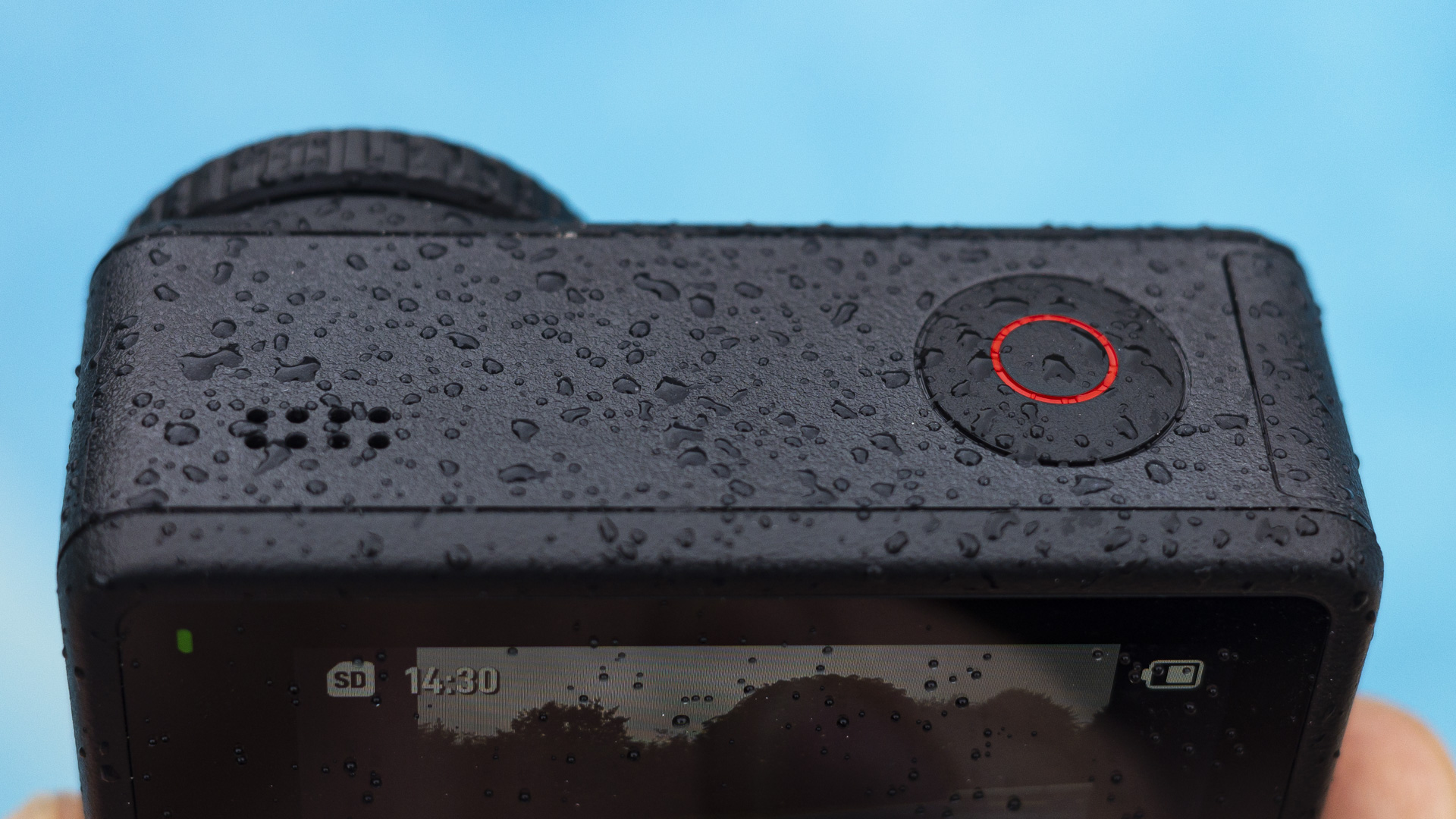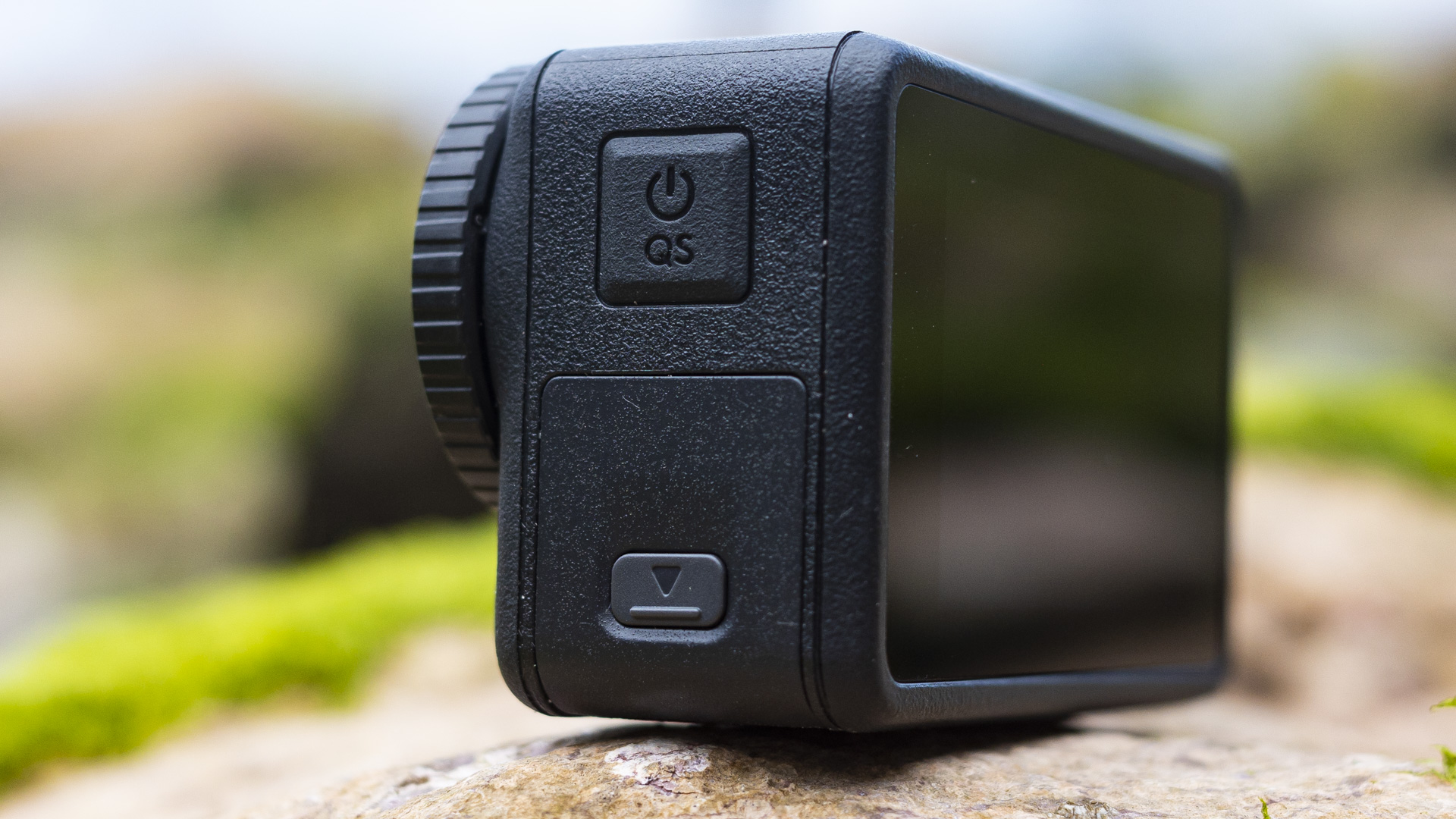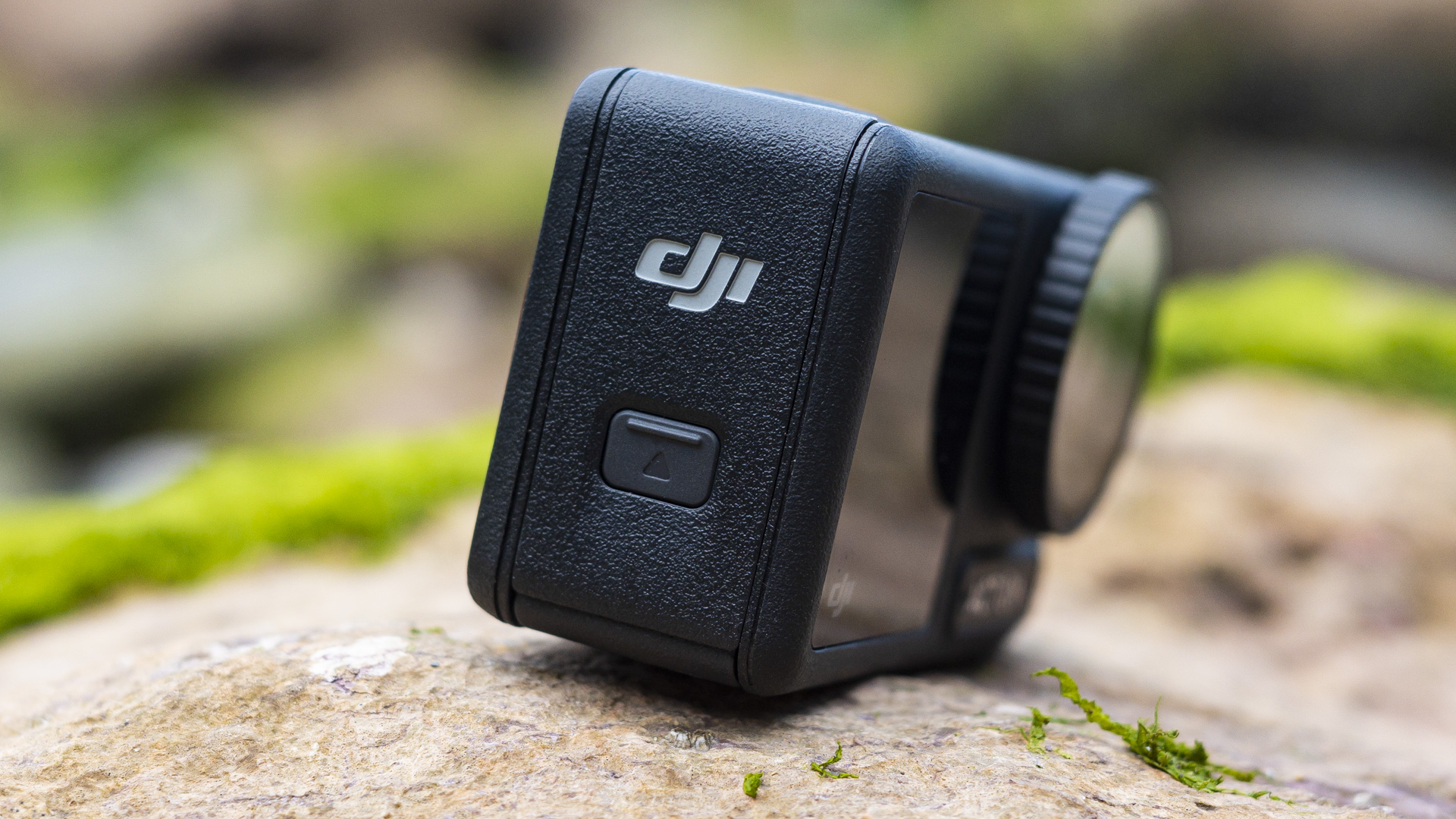
Two-minute review
We love the DJI Osmo Action 3, and its successor, the DJI Osmo Action 4 has arrived one year later, embodying the same design ethos, with the same tiny but rugged build, best-in-class waterproofing, a convenient magnetic mounting, a removable battery, and a handy front touchscreen.
So what's new? DJI has sought to address the Action 3's main weakness – photo and video quality – and it's done this by introducing an all-new, larger 1/1.3-inch sensor.
If that sensor size doesn’t mean much to you, it’s the same size as the one found in the Samsung Galaxy S23 Ultra, which is one of the best cameraphones, and its dimensions are around 25% bigger than the 1/1.7-inch sensor found in the Osmo Action 3.
Sensor: 10MP 1/1.3-inch CMOS sensor
FOV/focal length: 155 degrees/12.7mm
Max photo resolution: 3648 x 2736
Video: Up to 4K 120fps (16:9)
Stabilization: RockSteady 3.0+
Front screen: 1.4-inch, 320 x 320
Rear screen: 2.25-inch, 360 x 640
Photo resolution is actually lower this time around, down from 12MP to 10MP, while video resolution remains at 4K up to 120fps, plus a 8x slow-motion mode in Full HD. The bigger sensor and similar resolution combined means pixels are bigger than before, and more able to gather light and in turn improve image quality, especially in low-light; the achilles heel of even the best action cameras, including the GoPro Hero 11 Black.
We now also get DJI's D-Log color profile with 10-bit color, which when paired with that bigger sensor increases image quality dramatically, especially in terms of color depth and dynamic range. Detail in highlights like bright clouds and evening lights is maintained to a level not possible with the Action 3, while shadows look cleaner. D-Log isn't available in all video modes, but it's the profile to pick if the frame rates available are okay for what you're filming.
An adverse impact of the larger sensor in a camera with identical dimensions and 155-degree field-of-view lens is that the minimum focus distance is increased from 0.3m to 0.4m. That might not sound like a big deal, but in real-world use, and with that ultra-wide lens, you're consigned to all-encompassing views and not the details.
Otherwise, we get Rocksteady 3.0+ stabilization, which is incredibly effective. I've been able to sprint, at my admittedly dwindling top speeds, alongside a youthful canine in full flow, and the resulting video footage is smooth as silk. Downhill bikers will have no problems either – you won't need a gimbal with the Action 4.

Its class-leading waterproofing is even better, too, by an additional 2m down to maximum depths of 18m.
Elsewhere, specs and features mostly remain the same as in the Action 3, which is no bad thing. There's the excellent magnetic mounting system, which beats GoPro's efforts, the rear and front touchscreens, and a dumbed-down layout and menu that's quick and easy to navigate.
If you're trigger-happy you'll quickly burn through battery life, and we'd definitely opt for the Adventure Combo over the Standard Combo to gain two additional batteries and the charging hub that holds up to three batteries – you'll be using it every day on your trips to keep your camera powered up.
The 1.5m Extension Rod that comes with the Adventure Combo is a great accessory, too. Fully extended, and coupled with the camera's ultra-wide field of view, you can shoot drone-like perspectives, and it truly expands your shot-list repertoire.
I'd like to see a record button on the extension rod, but there is the moderately reliable voice activation for taking snaps when your hands can't reach the camera itself.
I use many cameras both professionally and for pleasure, and on vacation I think an action camera like the Osmo Action 4 might just trump my mirrorless camera as a second camera to my cameraphone – it can do adventurous things that I just can't do with my cameraphone, whereas I can get away with my cameraphone instead of my mirrorless camera in many scenarios. It's been a blast creating with the Action 4, and it's an easy action camera to recommend.

DJI Osmo Action 4: release date and price
- Standard Combo available to buy now for $399 / £379 / AU$629
- Adventure Combo costs $499 / £469 / AU$819
- Plethora of optional accessories
The Osmo Action 4 is available now, with the lowest-cost Standard Combo package costing $399 / £379 / AU$629. That’s a notable 25% mark-up from the Action 3, and similar to the GoPro Hero 11 Black’s launch price, meaning this camera is no longer a 'cheaper' alternative.
Stump up an extra 25% and you can get the Adventure Combo, which includes the 1.5m Extension Rod (also sold separately for $49 / £35 / AU$75), two extra batteries, and a battery case that can hold and charge up to three batteries. Unless you already have additional batteries, this is the package we'd go for.
The Osmo Action 4 is compatible with a wide array of optional accessories for capturing all manner of pursuits, including a wrist strap ($39 / £35 / AU$55), bike mount ($16 / £15 / AU$35), handlebar mount $39 / £35 / AU$69), 3.5mm audio adaptor ($45 / £45 / AU$79), Bluetooth remote controller ($79 / £69 / AU$135), lens cover ($19 / £19 / AU$39), and road cycling accessory kit ($79 / £69 / AU$125).
- Price score: 4/5
DJI Osmo Action 4: design
- Largely the same design as the Osmo Action 3
- A brilliant magnetic mounting system
- Best-in-class waterproofing to 18m
Design-wise, there's little to add that hasn't already been said in our DJI Osmo Action 3 review. Here we have the same rugged 145g body, removable 1,770mAh battery with a claimed 160-minute life (which in reality I think is a bit optimistic on DJI's part), microSD card slot and dual touchscreens.
The lens is the same 12.7mm f/2.8 optic with a 155-degree field of view; it's a sensible choice for vlogging and action videos, especially as you'll want to employ the excellent Rocksteady 3.0+ image stabilization, which incurs a small crop of the image area.








You'll want to keep the lens protector screwed on at all times to keep dust and dirt away from the lens, and to ensure that the class-leading 18m waterproofing is obtained. That lens protector can be swapped out for ND filters for shooting video in bright light, and DJI offers an optional ND filter pack that we used for this review.
The port doors on the left and right are, naturally, water-sealed too, and contain the USB-C port for charging and live connection, and the battery and microSD card slot.
The camera's base features a magnetic mount connector for landscape mounting, and in the box you also get a Protective Frame, which wraps around the camera and has an additional magnetic base to enable vertical, social-ready mounting in portrait orientation with the 4:3 aspect sensor.

As on the Action 3 there's a tiny 1.4-inch front touchscreen on the Action 4, enabling you to not only frame shots, but also control and navigate the menus when in selfie mode – not all action cameras offer this feature.
The main screen on the rear measures 2.25 inches, and is much easier on the eye when shooting action. Given that both screens are relatively small it's a fruitless exercise to scrutinize screen quality, but the screens are bright enough for clear viewing – I could easier track myself swimming underwater with the Action 4 on the Extension Rod a meter away.
There are few physical controls on the camera, and all are easy to locate, and control even with gloved hands. You get a generously sized record button and an on/off button, and that's about it. A nice touch is that the record button will wake the camera straight into recording a video, and then the camera will promptly power-off again after you've ended an impromptu recording.
- Design score: 4.5/5
DJI Osmo Action 4: features and performance
- Removable card storage is the dated microSD
- Super effective Rocksteady 3.0+ stabilization
- So-so battery life
- DJI Mimo app offers a decent UX
Photographers look away now – the Action 4 offers less than what we would hope for in 2023. Stills are only 10MP, and there's no obvious implementation of computational photography as we're seeing in the best cameraphones. For example, there's no portrait, night or HDR mode, and you're stuck with a super-wide-angle lens that's fairly limited regarding the types of scenes it's suited to capture.
On the plus side, colors are pleasant, and beyond the obvious and unavoidable barrel distortion that comes with such a wide field of view, lens distortion is well controlled. There's a tinge of chromatic aberration in the corners, which you can make out in magenta fringing around the tree leaves in the woodland photos included in the sample gallery below.
The reality is that the Action 4 is primarily for video, and we have all the video modes we've come to expect from an action camera; slow motion, hyperlapse and timelapse, in addition to 4K 60fps and 120fps, which means that skilled editors have the core features at their disposal to apply speed ramps in post, plus scope to crop into the 4K image for Full HD output.





Battery life is admirable, but the reality is that you'll need additional batteries for shooting video throughout a day – I completely drained two 1,770mAh batteries in a day on several occasions while testing the Action 4, and I would absolutely fork out the extra 25% to get the Adventure Combo rather than the Standard Combo.
In real-world use, I didn't have any issues with overheating or video record times, but under a more controlled environment at my desk, purely to test what was possible (and let's be honest, an unrealistic scenario), the camera did get warm to the touch, and video record times couldn't quite match the GoPro Hero 11 Black's best efforts.


The Action 4's UI is clean and simple, with large icons again suitable for stubby fingers even gloved hands, and features that include the likes of voice activation commands. Triggering the camera to take a photo by voice is super helpful when it's out of reach on the end of a 1.5m Extension Rod.
There's a 'Pro' mode for photo and video that opens up manual control of the camera's exposure parameters, including raw photo, plus you can switch from the ultra-wide field of view to cropped-in standard view at the cost of resolution. I saw little need for the Pro mode for photos, but utilized it for video in order to control white balance manually.
DJI's super-charged RockSteady 3.0+ image stablization is employed here, and delivers a staggering performance, enabling silky smooth video capture even in scenarios where I had the camera in hand doing a full sprint; I didn't encounter a scenario where I wished for a gimbal.
The DJI Mimo app impresses too, giving a reliable connection to the camera for remote live view with minimal latency. Ultimately, the Action 4 has proved to be a super-fun camera to use.
- Features and performance score: 4/5
DJI Osmo Action 4: image and video quality
- Modest 10MP stills
- 0.4m minimum focus
- Improved 10-bit 4K video quality
- D-Log color profile
The new 1/1.3-inch sensor is the headline feature in the Action 4. It's 25% bigger than the 1/1.7-inch sensor in the Action 3, which was already bigger than the GoPro Hero 11 Black's sensor.
If a better sensor was the only thing new about the Action 4 that would be fine, because it topped our wishlist, and the new sensor undoubtedly delivers better image quality.
What it doesn't do, however, is provide a bigger image – a GoPro tack. Video resolution is the same, and photo resolution is in fact lower despite the larger sensor – the modest 10MP JPEG-only photos are sufficient for viewing on tablets, but look at them on anything much larger and you'll notice the limitations. For context, the images in the GoPro Hero 11 Black are almost three times the size.
What the new and larger sensor achieves is improved color and dynamic range. Whether it's in bright sunshine or in low light, you'll see more detail in highlight areas such as white clouds, and I'd take these improvements in an action camera over a larger image any day.






4K video
I haven't done side-by-side comparisons of the Action 3 and Action 4, but those that I've seen demonstrate better low-light image quality. In the Action 4, night lights have more detail, including colored lights, where the Action 3 otherwise clips, and shadows look much cleaner.
If you shoot video using DJI's D-Log color profile – which is available in the Action 4 but not the Action 3 – then dynamic range is greater, provided you don't mind making tweaks post-capture to grade the flat image, which can be done in the DJI Mimo app or your choice of the best video-editing software.
You also have the option of shooting 10-bit 4K video – you're no longer limited to 8-bit. The difference in video color quality between 8-bit and 10-bit is night and day – 10-bit images in the latter can display more than one billion colors in total compared to 16.7 million colors in 8-bit.
Overall, the image quality of the Action 4 is much more rounded than the Action 3.
Both cameras, however, have a maximum 130Mbps video bitrate – ultimately the continued use of microSD limits potential video file sizes.
Hyperlapse video
By default the camera is set to auto exposure, which includes auto white balance. On the whole, brightness in videos is fine, but the camera doesn't appear to utilize face detection for exposure, and so some vlogging content came out a little dark. I'd also advise overriding auto white balance to manually select the appropriate setting, such as Daylight, to avoid obvious color temperature shifts that are next to impossible to correct in videos.
DJI's decision to stick with the same ultra-wide lens is the right call for an action-oriented camera, even for vlogging. But I do have a slight issue with the lens's 155-degree field of view, given that the minimum focus distance is now 0.4m. Put simply, there's many an occasion when you wish the camera focused closer to better fill the frame with your subjects – for me, swimming with jellyfish and tracking a butterfly in slow motion were such times.
Slow motion (8x) Full HD video
In addition to 4K 60p 10-bit video and a reasonable-quality 8x slow-motion Full HD video, we get timelapse and hyperlapse modes. In these sped-up video modes, the camera display powers off to conserve battery life, plus you can choose the video resolution and the camera will automatically create the video sequences.
The internal microphones do a decent job of capturing clean sound, though you will need to blow out any water droplets that gather in the mic holes and consequently affect audio quality. For less active videos, you can improve audio quality using a wireless mic like the DJI Mic; you simply plug the receiver straight into the USB-C port on the side of the camera.
- Image and video quality: 4/5
Should I buy the DJI Osmo Action 4?
Buy it if...
Don'y buy it if...
Also consider
Testing scorecard
How I tested the DJI Osmo Action 4
I had the DJI Osmo Action 4 Adventure Combo by my side throughout a long vacation by the coast, where I was able to use the camera in the water while swimming, kayaking, and paddle-boarding, as well as when running, hiking in the woods, on dog walks, and for general travel vlogging, both in the hand and mounted to the 1.5m Extension Rod. It's been an incredibly fun and capable camera to shoot with.
The user experience is a known quantity given the similarities to the Action 3; the Action 4 offers super-quick mounting and unmounting, which is especially helpful when you're mixing up your activities.
I've used all video modes, shooting 4K up to 120fps, slow-motion Full HD, timelapses and hyperlapses, and I pushed the camera to its limits to check max recording times.
First reviewed August 2023







